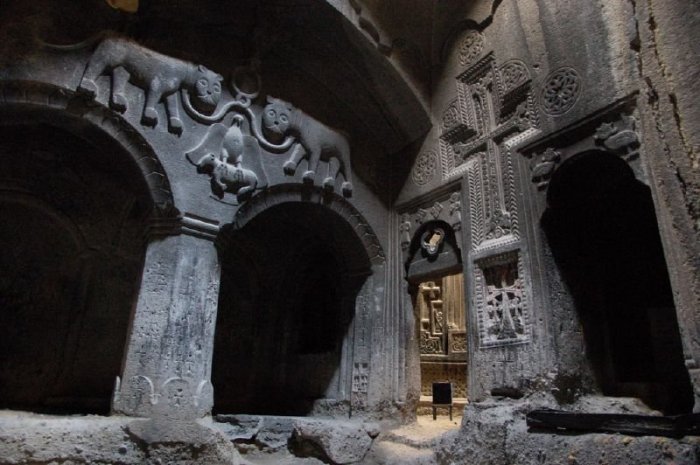A. Sutherland – AncientPages.com – The history of Geghard and traditions that date back to pre-Christian times, Armenians were influenced by the Persians and their Zoroastrian religion.
Initially, the monument was known as Ayrivank, and after the 13th century, it became known under the name of Geghard (in Armenian: “spear” or “lance“). This name is related to the Holy Spear, which was stored there.

Jamatun/first rock-cut chamber. Image credit: – CC BY-SA 2.0
The Geghard Monastery, located in the valley of the river Azat 30 kilometers East of Yerevan, has been a sanctuary for pilgrims over many centuries and one of Armenia’s most influential spiritual centers. The Church dedicated to the Holy Virgin Mary is the oldest hewn-in-the-rock monument in the Geghard Complex.
However, the place was used not only for religious celebrations and worship but also as a gathering place for discussing the country’s political, national, and social issues.
Tradition has it that the Monastery was founded by Saint Gregory the Illuminator (303 – 325). In the 4th century, it was the summer residence of St. Nerses the Great (353 – 373).
The Monastery, partly carved out of the cliff rocks, is surrounded by mᴀssive high walls on three sides and the mountain on the fourth. Inside are many interconnected chapels and a maze of caves, secret rooms, tombs, and khachkars (cross-stones) – outdoor steles carved from stone- consтιтute an authentic Armenian art form.
 Geghard Monastery – Armenia. Image credit: Beko – CC BY-SA 4.0
Geghard Monastery – Armenia. Image credit: Beko – CC BY-SA 4.0
The main cathedral of the cross-dome type was built in 1215, but legend has it that Geghard Monastery was founded in the 4th century. The first Monastery at this site was called Ayrivank (‘Cave monastery’ or the ‘Monastery of the Caves’) but was burned down and plundered in 923.
On the rock cliff walls near the cells and above the Church, there are intricately carved khachkars (stone crosses), and the carvings date to the early medieval period, but most are from the 11th-13th centuries, with a few from later periods.
According to legend, the apostle Thaddeus brought a spear to the Geghard Monastery, the same spear that had wounded Christ on the Cross.
In 1240, Armenian prince Prosh bought the Monastery and conducted a series of unique construction works along with the underground part carved out of rock.

Geghard Monastery- Khachkars inset in the rock outcropping. Image credit: Diego Delso – CC BY-SA 4.0
The earliest surviving part of the Monastery, the Chapel of the Mother of God, dates from before 1164. This chapel is partly connected with pᴀssages and small rooms, fully carved into the rock.
There are more than 20 other rock-hewn chapels and service premises, many of which have carvings depicting various animals, birds, and flowers and beautiful geometrical and floral patterns.
The southern facade has an attractive decoration in the form of prince Prosh’s coat of arms (lion attacking an ox) of the family of the Zakarian prince who built it. The lion symbolizes royal might.
 Arched entrance to the caves adjacent to the monastery. Liveon001 – CC BY-SA 3.0
Arched entrance to the caves adjacent to the monastery. Liveon001 – CC BY-SA 3.0
To the right of the mausoleum’s entrance, there are carved two sirens, mythical creatures with the crowned head of a woman and the body of a bird.
These creatures lived on rocky islets off the coast of Sicily and lured men to their death. They either enchanted them with their singing so they were shipwrecked on the rocks or, in some versions, lulled the men to sleep with their singing so that the sirens could murder them while they slept.
The Geghard Monastery complex contains numerous, perhaps even hundreds of monk cells carved in the surrounding cliffs. The Monastery had an ascetic tradition, and monks, originally hermits, lived, worked, and prayed in the cells. Many of them did not leave their small quarters until they died.

Geghard Monastery inside. Credit: Adobe Stock – Dmitriy Kandinskiy
The acoustics of the Monastery’s chambers is impressive. One of the churches has been designed with acoustics producing a remarkable and mysterious sound, almost like a divine echo. The acoustics allowed the rooms to ideally amplify monks’ chants when the Monastery was in use.
Monastic cells and several small churches were cut out of the surrounding volcanic tuff.
They represent an 11th-century feat of engineering and architecture of the Armenian masters.
Written by – A. Sutherland – AncientPages.com Senior Staff Writer
Updated on October 11, 2022
Copyright © AncientPages.com All rights reserved. This material may not be published, broadcast, rewritten or redistributed in whole or part without the express written permission of AncientPages.com
Expand for references
UNESCO
Monastery of Geghard and the Upper Azat Valley





